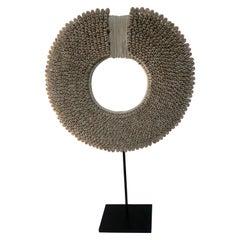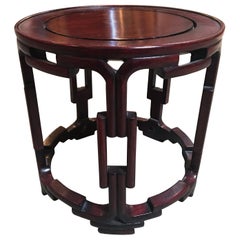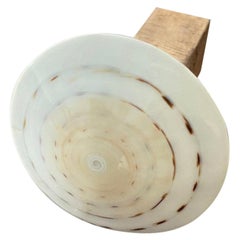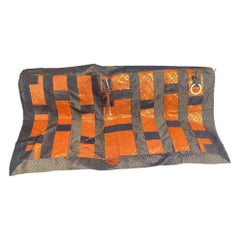Ceylon et Cie More Asian Art, Objects and Furniture
2
1
to
3
3
3
3
1
1
1
1
1
1
1
1
1
1
1
1
Located in Dallas, TX
Circular ceremonial shell necklace from Asia.
Category
2010s More Asian Art, Objects and Furniture
Materials
Beads
Located in Dallas, TX
This Chinese rosewood stand displays a brilliant red sheen. It's tabletop ...
Category
Mid-20th Century Chinese More Asian Art, Objects and Furniture
Materials
Rosewood
Located in Dallas, TX
Pair of 19th century vases
Famille Rose / Qing dynasty.
Category
Antique Late 19th Century Qing More Asian Art, Objects and Furniture
Materials
Porcelain
Related Items
By Andrianna Shamaris
Located in New York, NY
We have taken the flat bottom section of a cone shaped shell and added teak wood for beautiful one of a kind doo...
Category
2010s Indonesian Organic Modern Doors and Gates
Materials
Shell, Wood, Teak, Reclaimed Wood
Located in Studio City, CA
A wonderful, brightly coloured and somewhat rare fully intact Japanese Buddhist monk/ priest's Kesa ceremonial silk robe.
Kesa (which came from the Chinese word "kasaya") robes have been handmade/handstitched by monks/priests as an act of devotion as ceremonial robes for centuries in various Asian cultures (Japanese, Chinese, Korean, Vietnamese, Indian, etc). The kesa is a rectangular garment designed to be worn over the left shoulder (see example image). The robes are made (often in a patchwork column pattern ranging from five, seven, nine or more pannels) specifically for fully ordained Buddhist monks, priests and nuns and are made from donations of exquisite textiles from wealthy patrons of Japanese Buddhist temples. The robes were used in daily ceremonies, temple gatherings, and private meditation.
Antique Kesa robes...
Category
Antique 19th Century Japanese Edo Textiles
Materials
Textile, Brocade, Silk
H 41 in W 69 in D 0.1 in
Located in North Hollywood, CA
Antique Middle Eastern Qajar style Moorish picture photo album, with hand painted miniatures on the cover.
This...
Category
Antique Late 19th Century Moorish More Asian Art, Objects and Furniture
Materials
Paper
Located in Atlanta, GA
A impressive bronze Buddha head fragment displayed on wood stand circa late 19th century. The Buddha was cast in the early "U Thong" style that flourished between the 12-13rd century A.D in Central Thailand. The Buddha iconography of that period is exemplified by the influence from Mon and Khmer kingdom, featuring a more square face and a characteristic small band between the hairline and the forehead.
This large Buddha head...
Category
Antique 19th Century Thai Other Sculptures and Carvings
Materials
Bronze
Located in Yonkers, NY
A Chinese Qing Dynasty antique rattan round grain basket from the 19th century, with nice patina. Created in China during the 19h century, this grain basket features a thin lip sitting above a brown woven rattan body. With its rustic appeal and simple lines, this 19th century Chinese grain basket...
Category
Antique 19th Century Chinese Rustic Decorative Baskets
Materials
Rattan
Located in Yonkers, NY
A small Chinese Qing Dynasty period basket from the 19th century hand-woven with rattan on a bamboo armature. Cr...
Category
Antique 19th Century Chinese Qing Decorative Baskets
Materials
Bamboo, Rattan
Located in London, by appointment only
A fine set of ten polished brass ceremonial spears each with different and unusually elaborate symbolic spear heads representing good fortune, power and strength, long life, accomplishment. One of the few conventional spears is a rare Chinese spear with the double crescent moons either side of a elongated spear head. A Guan Dao...
Category
Antique Late 19th Century Chinese Qing Metalwork
Located in Greenwich, CT
Pair of Qing dynasty architecture carving panels, detail carvings with warriors riding horses.
Category
Antique 19th Century Chinese Qing Sculptures and Carvings
Materials
Wood
Located in New York, NY
A crystal ball decorative sphere decorative object with Chinoiserie wood base, circa late-20th century. A great ...
Category
Late 20th Century Chinoiserie More Desk Accessories
Materials
Crystal
By Ango
Located in Bangkok, TH
Auspiciousness Eggs by Ango is Feng Shui Egg Stone hand-weld and crafted for feng shui home decor items. Kotchakorn Promchai, the renowned Feng Shui master in Thailand invited Ango to create auspiciousness elements to enhance the Feng Shui of a space in a special collaboration. With their sophisticated craft these objects create a beautiful energy around them as well as commanding auspiciousness.
The meaning of Auspiciousness Feng Shui Eggs
Harmony, safety and a smooth path towards achieving goals are overall meaning of Auspicious Feng Shui Egg. The proportion of 52 to 54 mm in length signifies a wealthy life and the width of 42 to 44 mm signifies happiness and prosperity, while the coins placed inside each egg signify good fortune, good luck harmony and spiritual support.
• Silver Auspicious Egg
The colour of peace, justice, intelligence, future-facing, communication, maternity, happiness and prosperity.
• Gold Auspicious Egg
The colour of power, virtue, prestige, leadership, happiness and prosperity.
• Copper Auspicious Egg
The colour of elegance, happiness, charm, popularity, imagination and wealth.
The three colours of Auspiciousness Eggs
The three different colours of Auspiciousness Eggs reflect different aspects in the creation of new energy, happiness and prosperity. Bringing Auspiciousness Eggs into your home or place of work can bring harmony in love, along with good family relations and good fortune in your career, at the same time enabling wealth generation for you, your parents, children and the team who you work with.
The significance of the numbering used in creating the Auspiciousness Eggs
Number 1 signifies success, victory, smoothness in life, leadership and recognition.
Number 6 signifies unexpected fortune, divine blessing, imagination and happiness.
Number 8 signifies wealth, power, popularity and spiritual support.
Number 9 signifies a plenty of propitiousness and auspiciousness.
Each egg is then designed to house 8 silver coins, that are doubled so 16 coins in total; 9 gold coins that are then doubled, so 18 coins; and 10+9 copper coins so 19 coins in total. The technique of doubling is used to increase auspiciousness along with power, and the sequence 8, 9, 10 signifies an increasing power of auspiciousness. So with each piece of Auspiciousness Egg, the propitiousness is maximised in every way and it is recommended you can try one Auspiciousness Egg or one set of three eggs, to gain energy and then build up to 9 elements.
How to place by Auspiciousness Eggs for Feng Shui within your home.
One recommendation is to place the eggs on the desk space or study table. And for stock market investments, it is recommended the eggs are near to the computer. Another suggestion is on the cashier table, by the safe, or on a shelf with the other decorative items.
Who should have Auspiciousness Eggs?
The Auspiciousness Egg is a Feng Shui element that gains in energy starting with the determination patience and meditative skill shown by the artisans who create each piece by hand. This good fortune is for everyone no matter what year...
Category
21st Century and Contemporary Thai Arts and Crafts More Desk Accessories
Materials
Steel
H 1.8 in W 5.5 in D 5.5 in
Located in New York, NY
A unique wooden ladle with a half coconut shell attached, originally used for servin...
Category
Early 20th Century Tribal Serving Pieces
Materials
Wood, Reclaimed Wood, Shell, Coconut
Located in Bad Säckingen, DE
Antique Chinese Famille Rose Vase with Hand-Painted Enamels Qin...
Category
Antique 1890s Chinese Ceramics
Materials
Enamel




